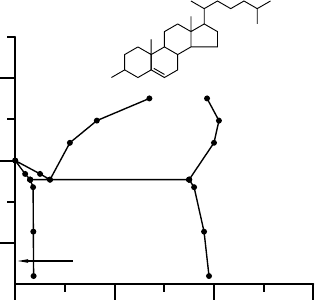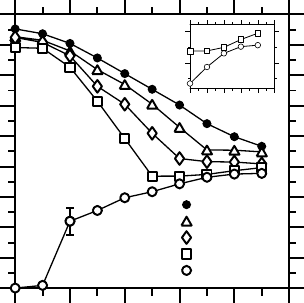Heitjans P., Karger J. (Eds.). Diffusion in Condensed Matter: Methods, Materials, Models
Подождите немного. Документ загружается.


12 Diffusion in Membranes 487
hole (void) nearby to which the lipid can move. The hole may arise from
a vacancy left behind by another lipid molecule, or from collective density
fluctuations in a bilayer.
In the case of a two-dimensional system, the free-volume theory assumes
that the single-particle diffusion coefficient can be written as [81]
D =
∞
a
∗
daD(a) p(a), (12.4)
where D(a) is the diffusion coefficient inside a free area a,anda
∗
is the
critical free area defined as the minimum value of a that allows a jump from
one site to another (D(a)=0fora<a
∗
). The p(a) is the probability of
finding a free area of size a, and is written as
p(a)=
Γ
a
t
− a
∗
exp
−
Γa
a
t
− a
∗
, (12.5)
where Γ is a geometric factor and a
t
is the average area per molecule. Thus
a
t
−a
∗
is the average free area per molecule. For constant D(a), one obtains
D = D(a
∗
)exp
−
Γa
∗
a
t
− a
∗
. (12.6)
This expression has later been extended to cases where energy fluctuations
are important [23,78].
Although both experiments [23, 64, 82, 83] and simplified model systems
[51,84] have provided support for the free-volume theory, one should bear in
mind that the critical free area a
∗
is assumed constant in this description,
while in practice the size and the shape of molecules in membranes fluctuate
in time (thus a
∗
depends on a
t
). Further, it has been proposed that the free-
volume theory is valid only at high densities over a relatively narrow range
of areas per molecule [66, 84]. Nevertheless, the free-volume approach has
been shown to describe diffusion specifically in the liquid-disordered phase of
single-component lipid bilayers [23].
It is worthwhile pointing out that the microscopic verification of the free-
volume theory is still missing. One way to clarify this issue and to provide
more insight into the diffusion mechanism is to look at the displacement ∆r
made by a tagged lipid during a time interval ∆t. If the idea of a two-stage
diffusion process were true, then the corresponding probability distribution
P (∆r, ∆t) would have a relatively narrow peak around ∆r ≈ R
L
.Thiskind
of experiment would be straightforward to carry out by MD simulations, and
has been employed in the case of benzene molecules diffusing inside a lipid
bilayer [76, 77]. For lipids in a bilayer, however, this idea is probably out of
reach at present due to the high computational cost. Perhaps forthcoming
model studies by MD and coarse-grained approaches (of the kind presented
in [46–49]) will clarify this issue.
488 Ilpo Vattulainen and Ole G. Mouritsen
Besides the free-volume theory, there are several theoretical descriptions
that have been suggested to describe lateral diffusion under different condi-
tions and in a variety of different systems. These descriptions are discussed
in a comprehensive manner, e.g., in [23, 78].
Anomalous diffusion
Lateral diffusion is often assumed to take place in an unrestricted environ-
ment such that the mean square displacement is linear in time. In membranes
this assumption cannot be taken for granted, however. This idea is supported
by a number of experiments [57,85–87] that have revealed how labeled mole-
cules may be temporally confined to some domain or compartment, or how
the mean square displacement may show anomalous behavior [88–90] as char-
acterized by |r(t)|
2
∼t
x
with x =1.
Anomalous diffusion may be due to a number of reasons (cf. also Chap. 10).
It has been suggested that proteins embedded in membranes may act as ob-
stacles [91] or binding sites [92] and therefore hinder the diffusion of molecules
in a bilayer. In this case the diffusion may look anomalous at small times. At
large times, though, one expects normal diffusion unless the motion of lipids
is bounded. The diffusion may look anomalous also in a situation where the
membrane is locally highly curved or characterized by strong out-of-plane
fluctuations. Then, if the diffusion of molecules is interpreted by looking at
their trajectories projected onto the average plane of the membrane, it may
resemble anomalous diffusion at short times. Also in this case, however, the
diffusion is expected to be normal at long times. Another possible scenario
giving rise to anomalous diffusion is the heterogeneity of the bilayer. Perhaps
the simplest example in this respect is a binary mixture of two lipids at a
temperature, where one of the lipids is in the fluid (liquid-disordered) and
the other in the solid-ordered phase. A DMPC-DSPC mixture is an example
of this situation [23]. Then in coexistence of the two phases there are both
liquid-disordered-rich and solid-ordered-rich domains, and the lateral diffu-
sion in the fluid phase is very rapid compared to the solid-ordered phase.
Thus, if the relative concentration of lipids in the solid-ordered phase exceeds
some critical value, one expects the solid-ordered phase to percolate through
the system, implying that long-range diffusion is no longer possible. In bio-
logical membranes including the cytoskeleton network the situation is even
more subtle, as the membrane-associated network may lead to domains in
which the molecules are trapped for a certain (and usually long) period. The
transient confinement associated with this situation reminds one of anom-
alous diffusion at small times, while at (very) long times the molecules are
eventually expected to diffuse from one domain to another.
We may conclude that anomalous diffusion is relatively common in mem-
branes. However, one should keep in mind that in many cases the diffusion
properties depend on the time scale studied. The true tracer diffusion coeffi-
cient characterizing the lateral motion of individual molecules is found only
12 Diffusion in Membranes 489
from the long-time limit through (12.1). Thus, if the technique used looks at
times prior to the long-time regime, it provides information of the dynamics
over a given time scale instead of the actual hydrodynamic limit.
Lateral Tracer Diffusion in a Lipid-Cholesterol Mixture
Cholesterol is a major component of the plasma membrane of animal eukary-
otic cells, comprising up to 50 mol % of the total lipid content [93]. A signif-
icant understanding of the role that cholesterol plays in the cell membrane
has been obtained from numerous experimental studies of lipid-cholesterol
model membranes [94]. These studies have demonstrated that cholesterol
has a variety of notable effects on the physical properties of lipid bilayers,
including an increase in the bulk bending modulus of bilayers containing
cholesterol [95], and changes in the orientational ordering of phospholipid
hydrocarbon chains [12]. Cholesterol also has a strong effect on the dynam-
ical properties of lipid bilayers, as is exemplified by numerous experimental
studies [62, 83, 96, 97] which have shown how cholesterol affects the rate of
lateral diffusion.
We shall here describe some observations for lateral tracer diffusion in
lipid bilayers containing cholesterol in order to illustrate how the diffusion
coefficient depends both on the phase state and the degree of conformational
order of long-chain lipid molecules. Off-lattice Monte Carlo simulations have
been used to study lateral diffusion [51] in lipid-cholesterol bilayers using a
two-dimensional minimal, strongly coarse grained model system [98,99]. This
study was motivated by two important ideas. First, the model predicted a
phase diagram in full qualitative agreement with the experimental phase
diagram of a lipid-cholesterol system. Second, since the model retains only
the key properties, which are expected to govern the behavior of interest
thereby omitting details of the molecular description which are not relevant
for phase behavior, one obtains an enormous reduction in the computational
cost of the simulations. This makes it possible to study much larger systems
for longer times, a feature which is necessary in order to be able to investigate
diffusion behavior over large time scales.
The phase diagram for the lipid-cholesterol model system [99,100] is shown
in Fig. 12.6. Figure 12.7 shows results for the lateral tracer diffusion coeffi-
cient D
T
of a lipid chain as a function of cholesterol concentration X
chol
for
temperatures T/T
M
=0.99, 1.0, 1.01, 1.02, and 1.03, where T
M
denotes the
temperature of the main phase transition.
It was found that for T ≥ T
M
, D
T
generally decreases as X
chol
is increased
from 0 to 0.45. For these temperatures, there is initially a slow decrease in D
T
for X
chol
< 0.1, followed by a more rapid decrease up to about X
chol
=0.3,
after which the curves tend to level off. An interesting observation is that
for T/T
M
=1.0, D
T
increases slightly with increasing X
chol
.Atthelowest
temperature of T/T
M
=0.99, D
T
increases monotonically with X
chol
. Finally,
for any value of X
chol
, D
T
always increases with increasing temperature.

490 Ilpo Vattulainen and Ole G. Mouritsen
0.0 0.1 0.2 0.3
X
chol
0.99
1.0
1.01
T/T
M
ld
ld+lo
lo
so
so+lo
HO
CHOLESTEROL
Fig. 12.6. The phase diagram for a model of a lipid-cholesterol mixture as a
function of temperature T and cholesterol concentration X
chol
. T
M
corresponds to
the temperature of the main phase transition. Shown here are the solid-ordered (so),
the liquid-disordered (ld), and the liquid-ordered (lo) phases. Coexistence phases at
intermediate cholesterol concentrations are also illustrated. The molecular structure
of cholesterol is shown in the inset.
Generally it was observed in the simulation studies that increasing the
cholesterol concentration suppresses D
T
due to an increased conformational
ordering of lipid chains. However, it seems likely that this effect competes with
an increase in the average free area per lipid, which favours an increase in D
T
.
The interplay of these two effects leads to the diffusion behavior shown in
Fig. 12.7, which in turn is in excellent qualitative agreement with available ex-
perimental results for lipid-cholesterol mixtures. In these systems the lateral
diffusion coefficient decreases by a factor of 2 – 3 for increasing the cholesterol
concentration from 0 mol %, when the system is in the liquid-disordered (ld)
phase for T>T
M
, to 50 mol %, for which the system is in the liquid-ordered
(lo) phase [51, 83]. Furthermore for T<T
M
, experimental observations are
in agreement with our results in the sense that increasing the cholesterol
concentration increases D
T
, with a rather abrupt change close to the phase
boundary between solid-ordered and liquid-ordered phases (so-lo) [69, 101].
In addition, the increase in D
T
with X
chol
at sufficiently low T in the lo
phase (T ≈ T
M
) observed in our simulations was also observed by Almeida et
al. [83] in their FRAP study of lateral diffusion of DMPC-cholesterol bilayers.
Overall, the model results are in good qualitative agreement with experiments
and furthermore provide support for the free-volume theory [51].
Given the simplicity of the model, the results for phase behavior and lipid
diffusion in the cholesterol mixtures are in remarkably good qualitative agree-

12 Diffusion in Membranes 491
0.0 0.1 0.2 0.3 0.4 0.5
X
chol
0
2
4
6
8
D
T
T/T
M
= 0.99
T/T
M
= 1.00
T/T
M
= 1.01
T/T
M
= 1.02
T/T
M
= 1.03
0.3 0.4 0.5
3.5
4.0
Fig. 12.7. Results for the lateral tracer diffusion coefficient of lipids in the model
of a lipid-cholesterol mixture as a function of cholesterol concentration X
chol
.The
curves correspond to different temperatures as described by T/T
M
.Theresultsfor
D
T
are given in units of σ
2
/t
MC
,whereσ is the length scale related to the hard-
core size of a molecule (see [98] for details), and t
MC
is the time in Monte Carlo
units. The inset shows details in the data in order to highlight the non-monotonous
behavior at T
M
.
ment with experiment. This demonstrates first of all that microscopic details
are in many cases irrelevant for the large-scale properties of complex systems
such as lipid membranes. Further, the good agreement between experiments
and the model system serves as an instructive example of how statistical
physics can contribute to studies of membrane systems. The key idea is to
use the concepts and methods of statistical mechanics to simplify complex
systems. In this manner, one can obtain models, which grasp the essential
features of the system with minimal effort. In the present case, we conclude
that the minimal model described in [51,98–100] is sufficiently well designed
to describe a wide range of physical behavior of lipid-sterol systems.
12.4 Rotational Diffusion of Single Molecules
The rotational motion of lipids and proteins is characterized by the rotational
diffusion coefficient D
R
. To this end, let us use (12.1) and replace r with θ.
The angle θ is chosen to represent the desired degree of freedom such as the
rotation of the vector
12
from one of the lipid acyl chains to another (i.e.,
the vector from the center-of-mass of the sn-1 chain to the center-of-mass
of sn-2) around an axis perpendicular to the bilayer plane. Then Einstein

492 Ilpo Vattulainen and Ole G. Mouritsen
equation yields
D
R
= lim
t→∞
1
2t
|θ(t) − θ(0)|
2
, (12.7)
where θ(t) − θ(0) is the overall change in the angle during a time period t
(thus θ is not bounded by −π and π). This definition is very suitable for
computational purposes, while in experiments it is less useful. The usual
way to circumvent this problem is to look at the decay of time correlation
functions that are written in terms of the Wigner rotation matrices [3, 39].
This approach is used in experiments such as NMR relaxation, and it is closely
related to the measurement of the lipid conformational order parameter [12],
which is one of the key quantities when the structure of lipid membranes is
being investigated.
As a specific example, one may consider the correlation function
C
2
(t)=P
2
(u(t) · u(0)), (12.8)
where u(t) is some unit vector at time t,andP
2
(x)=
3
2
x
2
−
1
2
is the second
Legendre polynomial. The unit vector u(t) can be chosen in various ways,
depending on the motion one wishes to examine. One commonly made choice
is to look at the time dependence of the CH unit vector of some methylene
group in an acyl chain. Then C
2
(t) essentially measures the rate of rotational
motion of this vector.
Once C
R
(t) has been measured, one has to fit the results to a decaying
exponential, whose decay rate yields a rotational relaxation rate, which is
proportional to D
R
. Alternatively, one can estimate rotational diffusion coef-
ficients by models such as the one developed by Saffman and Delbr¨uck [79],
who treated a lipid molecule (or a protein) as a cylinder. Within this de-
velopment, the lateral and rotational diffusion coefficients are coupled by
the membrane viscosity. However, as Moore et al. pointed out [70], these ap-
proaches are marred by the fact that molecules in membranes change their
shape in time and therefore they are not modeled well by a cylinder of some
fixed shape and size. Nevertheless, both approaches [(12.7) and (12.8)] have
been used with success to provide valuable information of rotational diffusion
in membranes.
As examples of recent studies on rotational diffusion, we discuss a the-
oretical and an experimental approach focused on single-molecule imaging.
Firstly, let us consider the MD work by Moore et al. for lipids in a DMPC
bilayer [70]. They found that the rotational motion of individual compo-
nents in a lipid span three orders of magnitude from about 25 rad
2
/ns to
0.04 rad
2
/ns. The fastest component corresponded to the rotation of the sn-1
and sn-2 chains (for a vector from the first to the last carbon of each chain),
while the rotation of interchain vectors such as
12
were found to be the
slowest modes in this system. Moore et al. also concluded that for most of
the components, the translational and rotational diffusion are over different
time scales and therefore uncoupled.
12 Diffusion in Membranes 493
Secondly, we consider a novel method, called single-molecule anisotropy
imaging, that permits a simultaneous measurement of lateral and rotational
diffusion on fluorescence-labeled lipids in a bilayer [59]. In contrast to large
bead labels, a single fluorophore has a well-defined transition dipole mo-
ment with respect to its structure. In the case of the head-group label rho-
damine, its dipole is oriented within the plane of the membrane. Under
proper conditions of excitation lifetime, rotational time scale, and obser-
vation time, the rotational diffusion can be imaged directly and the rota-
tional diffusion coefficient be derived. Harms et al. [59] found for supported
bilayers of POPC D
R
=0.07 rad
2
/ns in the liquid-disordered phase and
D
R
=1.2 × 10
−9
rad
2
/ns in the solid-ordered phase.
12.5 Lateral Collective Diffusion of Molecules in
Membranes
Like many complex soft-matter systems, membranes are characterized by col-
lective fluctuations that are essentially driven by thermal excitations. Out-
of-plane fluctuations such as undulations affect the shape and stability of the
membrane as is exemplified by the creation (budding) of liposomes [24] when
a part of the membrane separates from the parent membrane, or when a li-
posome breaks into two. The in-plane fluctuations, in turn, describe density
fluctuations in the plane of the membrane, and are related to area fluctu-
ations that may be one of the mechanisms, which lead to pore formation,
thus allowing passive diffusion of particles through membranes. Despite its
importance, it is rather surprising that the collective motions in membranes
are not well understood at the moment [102].
Here we deal with a collective aspect of motion related to density fluctua-
tions in membranes. The density fluctuations are characterized by the motion
of particles as local excess density is spread through collective diffusion. It
may sound surprising but in many cases it is the collective diffusion rather
than tracer diffusion that is measured in actual experiments.
12.5.1 Fick’s Laws
So far we have considered diffusion in terms of the Einstein equation that is
related to Brownian motion. However, the way how diffusion is described in
many textbooks is rather different (cf., e.g., (1.1) to (1.8) of Chap. 1). This is
probably due to the historical background since the so-called Fick’s laws were
likely the first attempt to grasp the essential ideas of mass transport. They
were formulated already in 1855 [103] by direct analogy with the equations
of heat conduction derived some years earlier by Fourier [104].
The starting point is a postulate that some of the quantities in a system
are conserved variables. In the case of diffusion, the conserved quantity is the

494 Ilpo Vattulainen and Ole G. Mouritsen
particle density ρ(r,t). The second necessary ingredient for a hydrodynamical
description that one is looking for concerns the explicit form for the driving
force in diffusion. The general assumption in this respect is that, for systems
close to their equilibrium state, mass transport across a certain unit area is
proportional to the gradient of the particle density normal to the unit area.
These two ideas are described by the continuity equation
∂ρ
∂t
+ ∇·j =0, (12.9)
and the phenomenological Fick’s first law for the particle current density
j(r,t)=−D(ρ)∇ρ(r,t), (12.10)
where the hydrodynamic assumption of large length scales and long time
scales is already implicitly included. When these two expressions are com-
bined, one obtains
∂ρ
∂t
= ∇·D(ρ)∇ρ(r,t). (12.11)
The emerging expression is a non-linear partial differential equation, which
unfortunately is not often analytically soluble. For this reason, one usually
makes an additional assumption that D(ρ) does not depend on the density of
the diffusing particles, or that this dependence is weak. Then we get a linear
partial differential equation
∂ρ
∂t
= D∇
2
ρ(r,t), (12.12)
which is nothing but the usual diffusion equation, which can be often solved
exactly to yield the diffusion coefficient D.
Based on Fick’s second law, (12.12), D describes the decay rate of a
(small) density gradient. Evidently this process does not characterize the
same thing as Einstein’s relation (12.1), and therefore one makes a clear
distinction between the two diffusion coefficients. The diffusion coefficient
corresponding to single-particle motion is the tracer diffusion coefficient D
T
,
while the collective motion of the whole many-particle system is denoted as
the collective diffusion coefficient D
C
. Depending on the physical situation,
D
T
may be equal to the self-diffusion coefficient (see, e. g., Chaps. 1 and 10)
and D
C
is sometimes also called the coefficient of chemical diffusion (cf., e. g.,
Chaps. 3 and 18) or transport diffusion coefficient (Chaps. 10, 18 and 23).
12.5.2 Decay of Density Fluctuations
To gain some further insight into the physical meaning of D
C
,letusbegin
with ρ(r,t), which describes the density of the lipid bilayer at position r at
time t. As the density of the system fluctuates in time, and we expect the

12 Diffusion in Membranes 495
system to be in equilibrium (or close to it), the relevant quantity here is the
density fluctuation δρ(r,t)=ρ(r,t)−ρ ,whereρ is the average density in
a membrane. Then we define the density-fluctuation autocorrelation function
S(r, r
,t)=δρ(r,t) δρ(r
, 0). (12.13)
Now we can write Fick’s second law [see (12.12)] for the fluctuation δρ(r,t)
and assume translational invariance without loss of generality. Consequently
we get Fick’s second law for the density autocorrelation function:
∂S(r,t)
∂t
= D
C
∇
2
S(r,t). (12.14)
In the hydrodynamic regime (small wave-vector k and large times), and as-
suming for simplicity the system to be isotropic, the corresponding Fourier
transform decays as
S(k,t)=S(k, 0) exp(−k
2
tD
C
). (12.15)
Thus S(k,t) provides an interpretation of D
C
in terms of the decay rate of
density fluctuations. With a suitable small value of k, the collective diffusion
coefficient D
C
can then be extracted from the long-time tail of (12.15).
As a concrete example, one may think of some region in a membrane
in which the local density is obviously larger than the average density in
equilibrium. Then the density gradient drives the system towards equilibrium.
However, since the excess density at this region cannot spread locally, it must
spread over large length scales (small k) in the course of long times, thus
giving rise to a hydrodynamic collective diffusion process.
12.5.3 Relation Between Tracer and Collective Diffusion
Under general conditions, there is no simple relationship between the two
diffusion coefficients D
T
and D
C
. This is noticed by considering the motion
of N (identical) labeled molecules in a membrane. Then the Green-Kubo
equation for tracer diffusion is given by
D
T
=
1
dN
N
i=1
∞
0
dt v
i
(t) · v
i
(0), (12.16)
and the corresponding Green-Kubo equation for collective diffusion is
D
C
=
1
dk
B
TρNκ
T
∞
0
dt J(t) · J(0), (12.17)
which for simplicity’s sake is here given for an isotropic system. The time
correlation function of the total particle flux J(t)=
N
i=1
v
i
(t) is described
in terms of velocities of the particles, the quantity ρ denotes the density of

496 Ilpo Vattulainen and Ole G. Mouritsen
particles studied in this case, and κ
T
is the corresponding compressibility.
The corresponding relations for nanoporous host-guest systems are (10.24)
and (10.25) of Chap. 10 (mind the difference in the notations for tracer (self-)
and collective (transport) diffusion in the respective communities).
Combining (12.16) and (12.17) yields
D
C
= D
T
1
k
B
Tρκ
T
1+
i=j
-
∞
0
dt v
i
(t) · v
j
(0)
N
i=1
-
∞
0
dt v
i
(t) · v
i
(0)
. (12.18)
We see that the cross-correlations v
i
(t) · v
j
(0) determine whether a sim-
ple expression between D
C
and D
T
can be established. Such an expression
emerges if the velocities (displacements) of different particles are not corre-
lated at all.Thenweget
D
C
= D
T
1
k
B
Tρκ
T
. (12.19)
This situation is expected to be reasonable at very low concentrations, since
then interparticle interactions are not important and (12.19) works well. Fur-
ther, since the thermodynamic factor approaches a constant value in this
limit, lim
ρ→0
k
B
Tρκ
T
= 1 [105], one obtains D
C
≈ D
T
at low concentra-
tions.
We can conclude that D
T
and D
C
are approximately equal provided that
interaction effects between the labeled particles are weak. In practice this
implies that one should look at the dilute regime at which the concentration
of labeled particles is small. Fortunately this is often the case in experiments
such as FRAP measurements where only a tiny fraction of lipid molecules
are labeled. However, several interesting issues remain unclear. For example,
what is the concentration at which the tracer diffusion begins to deviate sig-
nificantly from the collective diffusion, and how does the compressibility come
into play in collective diffusion. The latter question is particularly important
since the isothermal compressibility
κ
T
=
1
k
B
Tρ
N
2
−N
2
N
(12.20)
is related to particle number fluctuations in the plane of a bilayer. These
fluctuations, in turn, are expected to show anomalous behavior in the vicinity
of phase transition lines. Thus we can expect that D
C
may provide one with
information of phase transitions and the locations of boundaries between
different phases. Further, the compressibility underlines a marked difference
between the two diffusion coefficients, and it is therefore justified to expect
very different behavior of D
T
and D
C
under certain conditions. To address
these questions, we will discuss some model results in Sect. 12.5.5.
